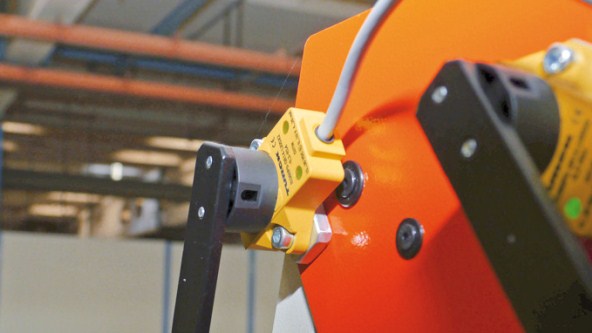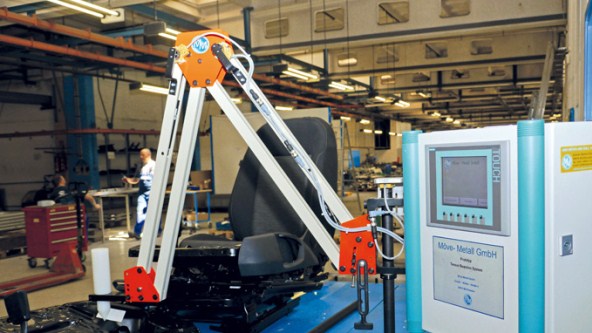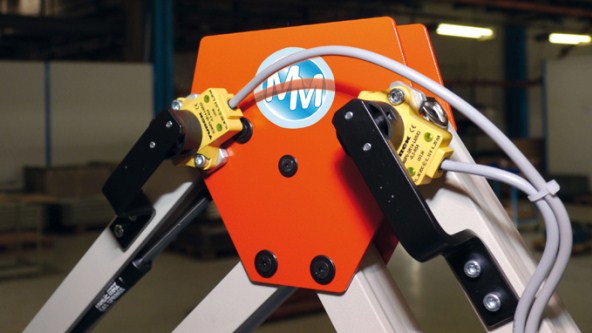Angle Sensors for Assembly Systems
The assembly systems with parallel arms from Möve-Metall are equipped with Turck's inductive RI angle sensors to ensure that screws are inserted exactly to specifications
Möve-Metall, a company based in Thuringia, Germany, produces assembly devices with parallel arms or other so-called reaction arms. Möve-Metall designs and produces assembly and testing equipment for car parts suppliers. The company developed a parallel arm with position detection for use in assembly processes which enables the position measuring of the screw and rivet processes and reliably prevents incorrectly assembled parts.
“A screwdriver device is clamped on the parallel arm. The operation is based on the principle of the parallelogram and ensures the precise and repeatable positioning of the screwdriver”, says Michael Zimmermann, technical manager of the company. The position monitoring at the three joints of the parallel arm is provided by Turck's inductive angle sensors. A beneficial spin-off of this is the fact that the forces involved with the assembly processes can be measured as well. This eliminates the effect of reaction torques on the user.
The parameters for each screw set are stored in the controller. If the operator wishes to screw in the first screw, he guides the arm to the appropriate position. The controller registers the correct position and releases the power or the compressed air for the screwdriver (first OK). The operator screws in the screw until the controller has registered the required number of screwdriver rotations (second OK) and the required torque has been reached (third OK), which guarantees that the screw is seated correctly. Only when these three OKs have been registered by the controller can the next screw be fitted. If the sequence was programmed beforehand, it is only possible to fit the screw that was stored in the controller as the second screw.
Tolerant sensors
“The position monitoring is relatively new," Zimmerman explains. "This offers an additional level of safety for the assembly process and is also easy to implement with the inductive angle sensor. A great benefit of the Turck sensor is its non-contact operation, thus requiring no mechanical connection to the positioning element. The four millimeter tolerance for the offset of the positioning element helps us considerably with the assembly process. We no longer have to fit so precisely and protect the sensor from contact, since slight impacts do not impair measuring."
Another benefit of the RI angle sensor is its immunity to magnetic fields and metal environments. The majority of other sensors on the market either have a mechanical connection between the rotary encoder and the sensor, or are susceptible to magnetic environments produced by large motors or welding equipment.
- Automotive
- Inductive Couplers Ensure Precise Material Feed
- Body Detection in Automobile Production
- Reliable Skid Detection in Automotive Production
- Error-free JIS Order Picking for Bumpers
- RFID Bus Mode Ensures Quality of Lithium-Ion Batteries
- Level Measurement in Dip Coating Line
- Level Control in Central Lubrication System
- Quality Assurance on the Gluing Robot
- Tilt angle sensor accelerates platform alignment
- IP67 Hybrid Module Processes Safety Signals
- Decentralized monitoring of cooling stations
- Robot welding cells networked with Ethernet
- Monitoring the cooling circuit on welding clamps
- Flow monitoring in drum washers
- Press Shop
- Body Shop
- Paint Shop
- Final Assembly
- Powertrain
- Item-level Detection with UHF RFID
- Supply of cooling lubricant in machine tools
- Controlling hydraulic pressure in pressing plants
- Measuring process pressure on scissor lifts
- Success Stories - Automotive
- Modular Plant for Flexible and Efficient Production
- Decentralized Safety Technology for Modular Production
- Modular Conveyor System
- RFID and I/O modules for Safe Tool Changes
- Muffler Production Wired with IO-Link Junction Boxes
- Workpiece Carrier Identification in Rear Vent Production
- Weld Nut Sensing
- RFID Traceability
- RFID in Engine Production
- Bumper Production with Identification
- Solutions for Paint Shops
- Welding and Assembly Sensors
- Angle Sensors for Assembly Systems
- Tool Identification
- Unique Products on the Conveyor Belt
- RFID in the Body Shop
- IO-Link Eases Differential Gear Production
- Chemical
- excom I/O System Enables Safe Hydrogen Liquefaction
- Decentralized Automation in Ex Areas
- RFID Control of Tube Connections in the Ex Area
- Ethernet Signal Connection in the I&C Room
- Ethernet-based Automation of Modular Skids
- Ex Isolation in Modular Process Plants
- Detection of Pigs
- Remote Signal I/O
- Easy Connection of Field Devices
- Signal Processing with System I/O in the Control Cabinet
- Signal Separation with Interface Technology in the Control Cabinet
- Identification of Hose Connections
- Efficient Monitoring of Cabinets in the Field
- Monitoring of Quarter Turn Actuators
- Planning and Assembly of System Solutions
- Success Stories
- Efficient Cooling of Industrial Furnaces with Turck's FS+ Flow Sensors
- I/O System Excom Creates Space in the I&C Rooms
- Zone 2 and 22 RFID
- Efficient Testing Control
- Intrinsically Safe Field Communication
- Process Control System Partnership
- Hazardous Area Remote I/O
- Dual Valve Position Feedback
- Flexibility with Fieldbus
- Asset Management with Remote I/O
- Correct Positioning with RFID in Carbid Production
- Fast conversion in restricted space
- Energy
- Food and Beverage
- Dough Thickness Control in Rolling Machines
- Identification of Food Containers
- Detection of Valve Position
- Detection of Pipe Elbows
- Identification of Chocolate Molds
- Success Stories
- Cloud-based Maintenance for Steam Generators
- RFID Support Enables Track and Trace in Food Production
- Grist for the Mill
- Decentralized Control Modules in Cold Storage
- Track and Trace in Meat Production with RFID
- Contact-free Encoder in Potato Production
- UHF RFID in Food Distribution Center
- RFID for Chocolate Production
- Distributed I/O for Food Equipment
- Remote I/O for Distilleries
- RFID and Autoclaves
- Transparency in Chocolate Manufacturing
- IP67 Power Supplies for Conveyors
- Identification in Food Product Storage
- Logistics
- Preventing Package Jams in the Logistics Center
- Tracking Big Bags with RFID
- Access Control for Protected Areas
- Decentralized Muting of Electro-sensitive Protectice Equipment
- Fast Tag Detection at Warehouse Gates
- Preventive Maintenance on Conveyor Belts
- Detection of Transport Containers
- Level Detection in Vessels
- Identification of Cryovessels
- Identification of Mobile Containers with Handheld Devices
- Identification of Food Containers
- Tier 1 – Bumper Identification
- Collision Protection on Reach Stackers
- Success Stories
- Logistics: RFID Reduces Error Quota by 99 Percent
- Sustainable Tracking of RTIs thanks to RFID
- RFID with HF Bus Mode Eases Seed Storage
- RFID Enables Unmanned Store at Major Building Site
- I/O and Safety Modules Increase Throughput in Intralogistics
- Shipment Tracking for Raw Materials
- RFID-based Shipment Control Minimizes Errors
- RFID-based Tracking of Inbound and Outbound Materials
- Decentralized UHF RFID Solution
- Contact-free Encoder in Potato Production
- Decentralized Control Modules in Coldstore
- IP67 Power Supplies for Conveyors
- Modular Conveyor System
- RFID Solution for Warehouse
- RFID Identifies Pharmaceuticals
- UHF RFID in Food Distribution Center
- Mobile Equipment
- Condition Monitoring Sensor Automates Climate Control
- Automatic Slope Compensation
- Distribution Lines for Field Sprayers
- Angle Measurement on a Field Sprayer
- Determining the Boom Angle Position
- Two-Axis Tilt Measurement on a Combine Harvester
- Collision Protection on Reach Stackers
- Success Stories
- RFID Solution with Smart Forklifts in Automobile Production
- Safe Remote Maintenance of Irrigation and Drainage Pumps
- Access Control with RFID System
- Selective Asparagus Harvester
- Position Measurement with RFID and Encoder
- Block I/O Modules on Super Yacht
- Wear-free encoder on hopper dredger
- I/O for Dust Suppression
- Cabinet Cooling
- Quick Disconnect Connectivity
- Automation Solutions for Extreme Cold
- Remote I/O for Cranes
- Rugged Heavy Metal Lifting
- Rollercoaster Positioning
- Mobile Machinery Solutions
- Exact Height Positioning
- Critical Angle Sensing
- Angle Indicator
- Oil and Gas
- Packaging
- Decentralized RFID Package Verification
- Identification of Printing Color Cartridges
- Reliable Operation of Machines
- Monitoring of Caps in Filling Lines
- Monitoring Changeover Processes
- Identification of Test Bottles
- Level Monitoring of Ground Coffee
- Level Detection in Vessels
- Detection of Transport Containers
- Success Stories
- Pharmaceutical
- End-to-End Sample Tracking with RFID
- RFID Control of Tube Connections in the Ex Area
- Decentralized Package Verification
- Automate Modular Skids
- Ex Isolation in Modular Process Plants
- Control of Valve Interfaces
- Monitoring of Quarter Turn Actuators
- Detection of Pipe Elbows
- Easy Connection of Field Devices
- Identification of Cryovessels
- Identification of Mobile Containers
- Identification of Mobile Containers with Handheld Devices
- Identification of Hose Connections for Precursors
- Identification of Hose Connections in Sterile Areas
- Identification of Big Bags and Bioreactors
- Identification of Single-Use Applications
- Success Stories
Select Country
Turck worldwide







